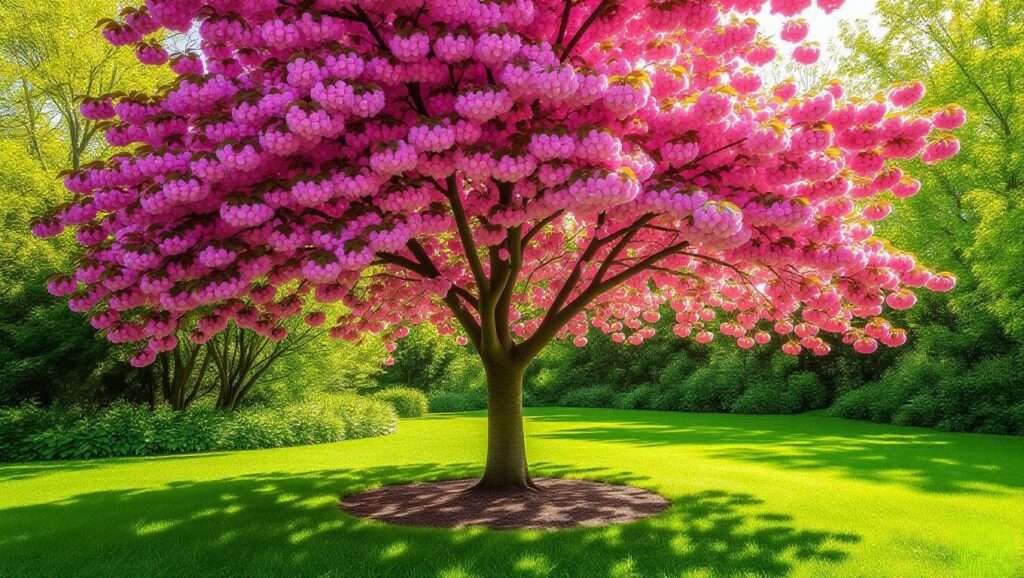Imagine plucking ripe, juicy cherries from your own backyard, even if it’s cloaked in shade! Many gardeners believe cherry trees demand full sun to flourish, but that’s a myth we’re here to bust. With the right strategies, you can master how to grow cherry trees successfully in the shade, transforming low-light spaces into thriving orchards. Whether you’re dealing with a shaded urban patio or a tree-covered yard, this guide delivers expert-backed, actionable advice to grow healthy cherry trees. Drawing on horticultural research and real-world success stories, we’ll empower you to overcome shade challenges and enjoy homegrown cherries. Let’s dive in!
1. Understanding Cherry Trees and Shade Requirements 🌿
Growing cherry trees in less-than-sunny conditions starts with understanding their needs and how shade impacts growth. This section lays the foundation for success by exploring cherry tree biology and light dynamics.
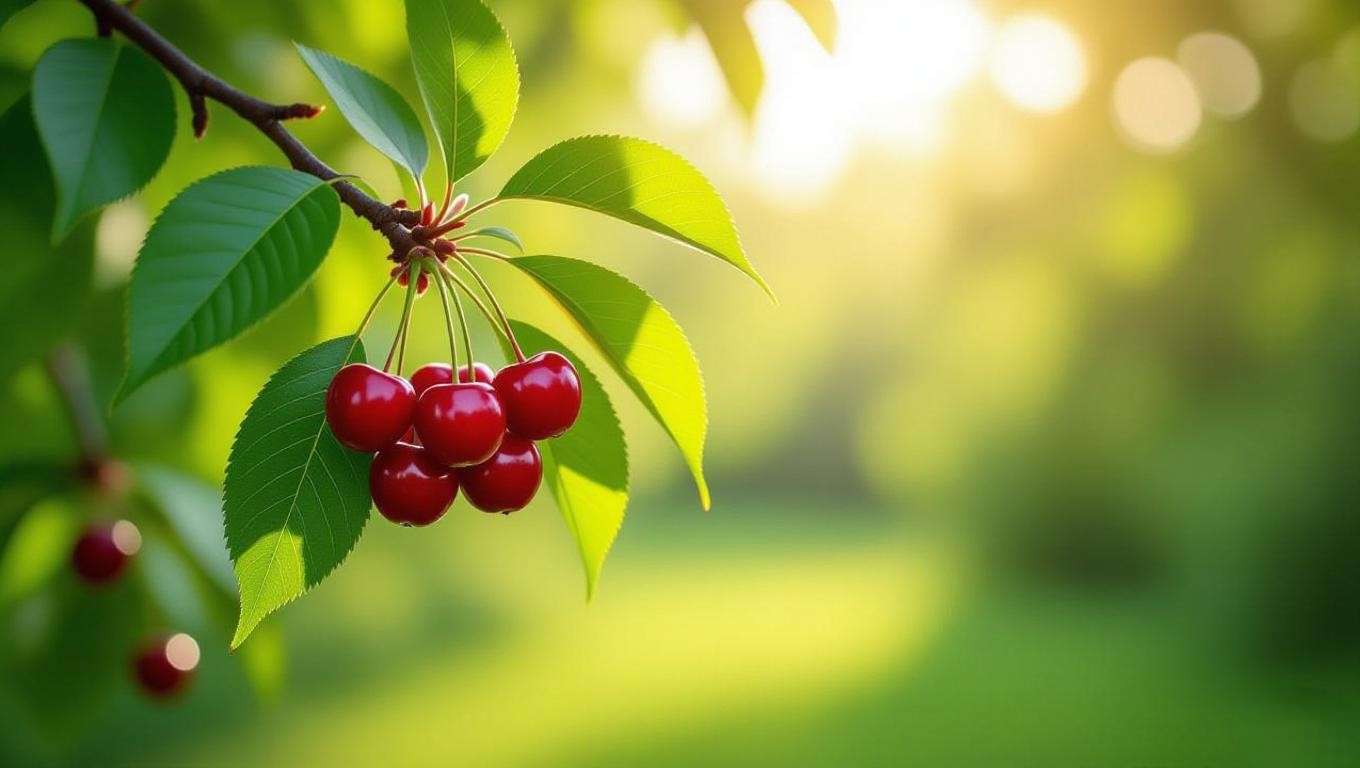
1.1 What Makes Cherry Trees Unique? 🍒
Cherry trees (Prunus avium for sweet cherries, Prunus cerasus for tart) are prized for their vibrant fruit and ornamental beauty. Popular varieties like Bing, Rainier, and Montmorency differ in flavor, size, and growth habits. Most cherry trees prefer 6–8 hours of direct sunlight for optimal fruiting, as sunlight fuels photosynthesis, driving energy for growth and fruit production. In shade, photosynthesis slows, potentially reducing yields or stunting growth. However, certain varieties and techniques can adapt cherry trees to lower light, making shaded gardens viable for cultivation.
1.2 Defining “Shade” in Gardening Terms 🌞
Shade isn’t a one-size-fits-all term. Gardening shade falls into three categories:
- Full shade: Less than 2 hours of direct sunlight daily, often under dense canopies or buildings.
- Partial shade: 2–4 hours of direct sun or dappled light through trees.
- Dappled shade: Filtered light through tree leaves, offering soft, indirect sunlight.
To assess your garden’s shade, use a light meter or a smartphone app like Sun Seeker to track sunlight hours. Common shaded spots include areas under taller trees, near fences, or in urban courtyards. Understanding your site’s light profile is critical for cherry tree success.
Expert Insight: Arborist Dr. Jane Miller recommends observing your garden over a week to map light patterns, noting that even dappled light can support certain cherry varieties if managed well.
2. Can Cherry Trees Really Grow in the Shade? 🌲
The idea that cherry trees can’t thrive in shade is a common misconception. With the right varieties and care, you can grow fruitful trees in low-light conditions.
2.1 Debunking Myths About Cherry Trees and Sunlight ☀️
Many assume cherry trees need full sun to produce fruit, but research from the University of Minnesota Extension shows that some cultivars tolerate partial shade with minimal yield loss. Shade reduces photosynthesis, but strategic care—like pruning or soil enrichment—can compensate. Real-world gardeners have grown cherries in partially shaded yards, proving it’s possible with the right approach.
2.2 Shade-Tolerant Cherry Tree Varieties 🍎
Not all cherry trees are equal when it comes to shade tolerance. Here are top picks for low-light gardens:
- Morello: A tart cherry thriving in partial shade, ideal for cooking or preserves.
- Stella: A self-pollinating sweet cherry that adapts well to dappled light.
- Montmorency: A hardy tart cherry known for resilience in less sunny conditions.
- Dwarf varieties: Compact trees like Cherry Baby or Nabella suit small, shaded spaces.
These varieties have lower light demands and compact growth habits, making them perfect for urban or shaded gardens.
Case Study: Sarah, a Seattle gardener, grew Montmorency cherries in her partially shaded backyard. By choosing a dwarf variety and pruning strategically, she harvested 10 pounds of fruit in her third season.
3. Preparing Your Shaded Garden for Cherry Trees 🌱
A well-prepared garden sets the stage for healthy cherry trees. This section covers soil, location, and site optimization for shade.
3.1 Soil Requirements for Shaded Cherry Trees 🌍
Cherry trees thrive in well-draining, loamy soil with a pH of 6.0–7.0. Shaded areas often retain moisture, increasing the risk of root rot. Test your soil with a home kit or send samples to a local extension service. Improve drainage by adding organic matter like compost or well-rotted manure. Incorporate perlite or sand for heavy clay soils. Nutrient-rich soil supports shade-grown trees by compensating for reduced photosynthesis.
3.2 Choosing the Right Location in a Shaded Yard 📍
Even in shade, microclimates matter. Choose a spot with at least 3–4 hours of dappled or direct light. Avoid deep shade under dense evergreens, as competition for water and nutrients can stress cherry trees. In urban settings, place trees near reflective surfaces (like white walls) to bounce light onto leaves. Prune nearby shrubs to reduce shade and improve airflow.
Pro Tip: Use a light meter app to confirm at least 3 hours of usable light daily. Reflective mulch, like white gravel, can boost light exposure by up to 20%.
4. Planting Cherry Trees in the Shade: Step-by-Step Guide 🌳
Proper planting ensures your cherry tree establishes strong roots, even in low light. Follow this guide for success.
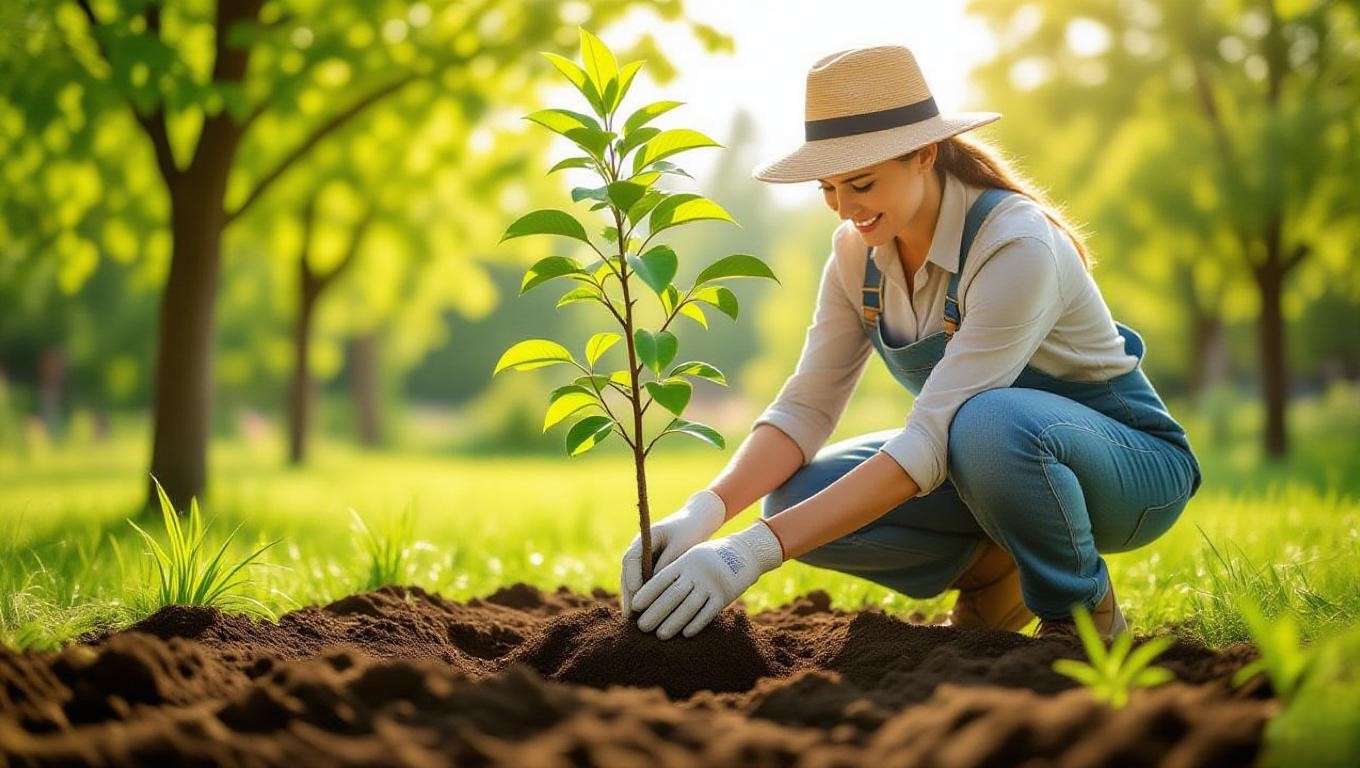
4.1 When and How to Plant Cherry Trees 🕰️
Plant in early spring or fall to avoid heat stress. Here’s how:
- Choose a healthy tree: Select a 1- to 2-year-old bare-root or potted tree from a reputable nursery.
- Dig the hole: Make it twice as wide and as deep as the root ball.
- Amend soil: Mix compost into the native soil for nutrients.
- Plant carefully: Place the tree so the root collar sits at soil level. Backfill and tamp gently.
- Water thoroughly: Soak the soil to settle roots.
In shade, ensure the planting site has good drainage to prevent waterlogging.
4.2 Mulching and Watering for Shade-Grown Trees 💧
Mulch with 2–3 inches of organic material (bark or wood chips) to retain moisture and regulate soil temperature. Keep mulch 2 inches from the trunk to avoid rot. Water deeply once a week, providing 1–2 inches of water, but reduce frequency in shaded areas to prevent soggy soil. Use a moisture meter to avoid overwatering.
Checklist:
- Test soil pH and drainage.
- Choose a spot with dappled light.
- Apply mulch evenly.
- Water consistently but cautiously.
5. Caring for Cherry Trees in Shaded Conditions 🌼
Ongoing care is crucial for shade-grown cherry trees. This section covers pruning, fertilizing, and pest management.
5.1 Pruning for Optimal Light and Airflow ✂️
Pruning is vital in shade to maximize light penetration and reduce disease risk. In late winter, remove:
- Dead or crossing branches.
- Dense inner growth to open the canopy.
- Suckers or water sprouts.
Aim for an open-center shape to allow dappled light to reach inner branches. Annual pruning prevents overcrowding and boosts fruit production.
5.2 Fertilizing Shade-Grown Cherry Trees 🌾
Use a balanced fertilizer (10-10-10) in early spring to support growth. Apply 1 pound per year of tree age, spread evenly around the drip line. Avoid over-fertilizing, as excess nitrogen can lead to leafy growth at the expense of fruit. Organic options like fish emulsion or compost tea work well for eco-conscious gardeners. Test soil annually to monitor nutrient levels.
5.3 Pest and Disease Management in Shady Environments 🐞
Shaded areas are prone to fungal diseases like powdery mildew or brown rot due to poor air circulation. Monitor for:
- Aphids: Spray with neem oil or insecticidal soap.
- Cherry fruit flies: Use sticky traps to reduce populations.
- Fungal issues: Apply copper-based fungicides early in the season.
Improve airflow by spacing trees 10–15 feet apart and pruning regularly.
Expert Tip: Certified arborist Tom Lee suggests using organic neem oil weekly during humid springs to prevent fungal spread in shaded orchards.
6. Maximizing Fruit Production in the Shade 🍒
Even in low-light conditions, you can boost cherry yields with smart strategies. This section explores pollination and light-enhancing techniques to ensure a bountiful harvest.
6.1 Pollination Strategies for Shaded Cherry Trees 🐝
Pollination is critical for fruit set, and shade can limit pollinator activity. Here’s how to ensure success:
- Choose self-pollinating varieties: Trees like Stella or dwarf cherries don’t require a second tree for pollination, ideal for small, shaded gardens.
- Attract pollinators: Plant shade-tolerant flowers like bee balm or lavender near your cherry tree to draw bees. These plants thrive in partial shade and boost pollinator visits.
- Hand-pollination: In urban or low-pollinator areas, use a soft brush to transfer pollen between flowers. This is especially effective for tart cherries like Morello.
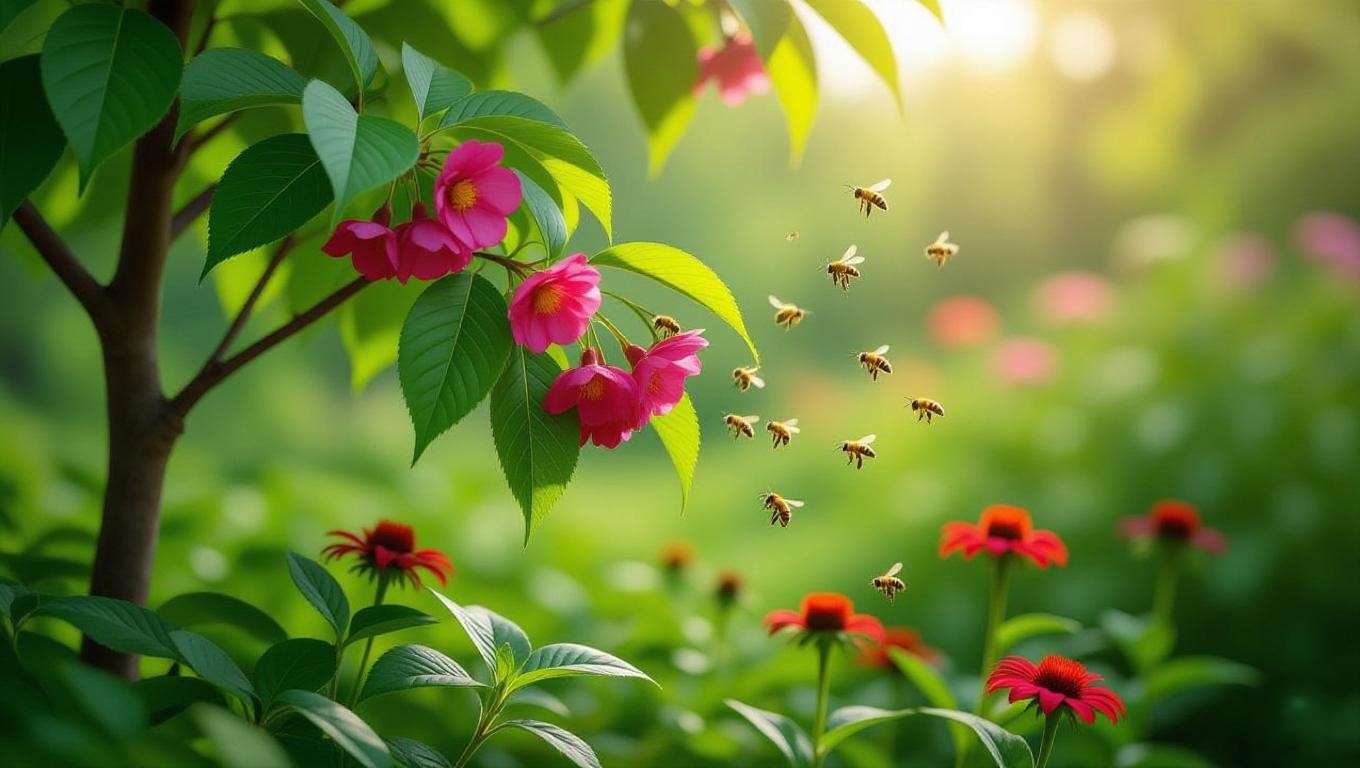
Ensure your tree blooms during peak pollinator activity (spring) by monitoring local weather patterns.
6.2 Enhancing Light Exposure Without Removing Shade 🌞
Maximizing available light is key in shaded gardens. Try these techniques:
- Reflective mulch: Spread white gravel or reflective fabric around the tree base to bounce light onto leaves. Studies show this can increase light exposure by 15–20%.
- Companion planting: Grow low-growing, shade-tolerant plants like hostas to fill space without blocking light. Avoid tall competitors like sunflowers.
- Strategic timing: Prune just before bud break to ensure light reaches developing flowers and fruit.
Success Story: Emma, a Portland gardener, doubled her Stella cherry yield by using reflective mulch and planting pollinator-friendly clover in her shaded yard. Her tree, tucked under a maple, produced 15 pounds of fruit in its fourth year.
7. Troubleshooting Common Challenges 🌧️
Shade-grown cherry trees face unique challenges. This section helps you diagnose and fix issues to keep your tree thriving.
7.1 Slow Growth or Poor Fruiting: What’s Going Wrong? ❓
If your cherry tree isn’t growing or fruiting well, consider these culprits:
- Insufficient light: Ensure at least 3–4 hours of dappled or direct light. Relocate dwarf trees in pots if needed.
- Nutrient deficiencies: Yellowing leaves may indicate nitrogen or potassium shortages. Test soil and apply a balanced fertilizer.
- Overwatering: Shaded soils stay wet longer, so check soil moisture before watering.
Solutions include adjusting watering schedules, enriching soil with compost, or using reflective materials to boost light.
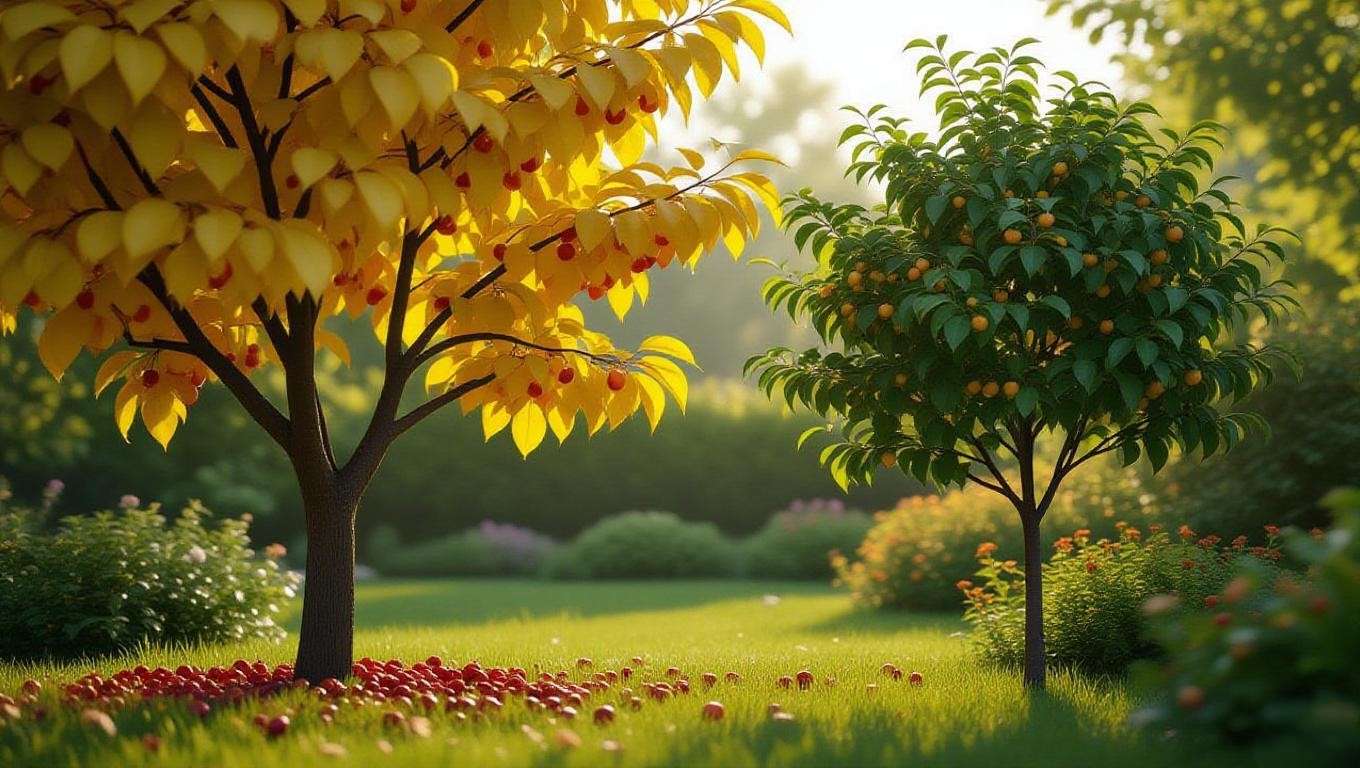
7.2 Dealing with Excessive Shade or Competition 🌳
If your tree is under dense shade or competing with larger plants:
- Thin nearby vegetation: Prune overhanging branches from neighboring trees to increase light and reduce root competition.
- Relocate young trees: If a tree is under 2 years old, transplant it to a brighter spot in early spring.
- Use root barriers: Install barriers to prevent nearby trees from stealing nutrients.
Quick Fixes Table:
| Problem | Symptoms | Solution |
|---|---|---|
| Slow growth | Small leaves, thin branches | Test soil, fertilize, increase light |
| Poor fruiting | Few or no cherries | Ensure pollination, prune for light |
| Fungal diseases | Powdery coating, wilting leaves | Apply fungicide, improve airflow |
8. FAQs About Growing Cherry Trees in the Shade ❓
Here are answers to common questions, backed by horticultural expertise:
Q1: Can cherry trees survive in full shade?
A: Full shade (less than 2 hours of direct light) is too dark for most cherry trees. Opt for partial or dappled shade and choose varieties like Morello or Stella for best results.
Q2: Which cherry tree varieties are best for shaded yards?
A: Morello, Stella, Montmorency, and dwarf varieties like Nabella thrive in partial shade. Select self-pollinating trees for smaller spaces.
Q3: How often should I water a cherry tree in a shaded area?
A: Water once weekly, providing 1–2 inches, but check soil moisture first. Shaded areas retain water longer, so avoid overwatering.
Q4: Can I grow cherry trees in pots in a shaded patio?
A: Yes! Dwarf varieties like Cherry Baby grow well in pots. Place them in a spot with 3–4 hours of dappled light and ensure proper drainage.
Q5: How long does it take for a shade-grown cherry tree to bear fruit?
A: Expect fruit in 3–5 years for standard trees or 2–3 years for dwarfs, depending on variety and care. Shade may slightly delay fruiting.
Conclusion: Your Path to a Thriving Shaded Cherry Orchard 🌟
Growing cherry trees successfully in the shade is not only possible but rewarding with the right approach. By selecting shade-tolerant varieties like Stella or Morello, preparing nutrient-rich soil, and optimizing light through pruning and reflective mulch, you can cultivate a flourishing orchard in low-light conditions. Regular care, from proper watering to pest management, ensures your trees thrive despite shade challenges. Whether you’re an urban gardener or nurturing a backyard grove, these expert tips empower you to enjoy homegrown cherries.
Ready to start? Share your cherry tree journey in the comments or try these techniques in your garden. With patience and care, your shaded orchard will yield sweet (or tart!) rewards. 🍒

